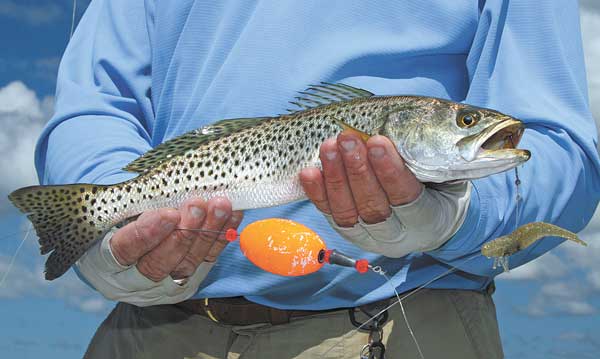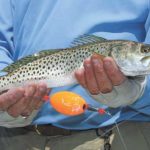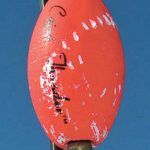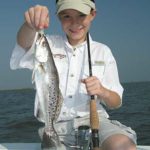
This time of year, floating saltwater baits rather than retrieving them offers practical and strategic benefits.
If the pun police and the cliché cops can look aside for a moment, we need to point out that a popping cork is the fishing world’s ultimate example of bait-and-switch. Consider the origin of that phrase: A retailer advertises a particular deal on a particular product — usually something that sounds too good to be true — but when a consumer attempts to make the purchase, he’s told that the original product has been replaced by another.
Out of stock, the guy before you bought the only one — the excuses are endless, but the reality is clear: Savvy marketing pros and slick-talking salesmen know that once they get a consumer ready to buy, they can often close them on something else.
Now, fish don’t walk into car dealerships and they don’t shop online, but their natural instincts can be manipulated just the same. One might make the argument that any artificial lure fits this premise, and that argument would certainly hold water. However, we’re talking about trickery on a much deeper level.
This gimmick marches a fish up the hill of hunger and pushes him right over the cliff by stirring up those feelings that drive every living creature into fits of aggression — jealousy, envy, greed. Food itself does not motivate a fish as much as the thought of another fish eating it. For schooling fish or solo acts, let a predator get wind of a nearby feed, and he’ll make tracks to the dinner table.
That’s the popping cork strategy. It’s an easy technique to execute, and all the elements of a legitimate feed are all there. You have the splash, the noise and the vibrations characteristic of another fish putting the chomp on lunch. All you’re missing is that other fish. Of course, the prospective buyer doesn’t mind, once he spots the bait below the cork, it’s an easy sell.
Playing the part
Here’s how it works: You hang a natural or artificial bait below a cork, sling the rig toward your target — defined or general — and retrieve it with a varying cadence or reeling and jerking. Made with upward or sideward sweeps, the latter movement causes the cork to slurp across the surface with a noise that sounds a lot like a fish rising topside to gobble a meal. When nearby predators hear the commotion, they instinctively race to see if there’s any leftovers.
For clarity, the term “popping cork” is often broadly used to describe any float that anglers tug across the surface. True popping corks, the tapered floats that slide onto the line, have concave tops that catch the water and create a chugging sound similar to a Pop-R or a Chug Bug.
For a noisier presentation, clacking cork rigs comprise a float flanked by plastic and brass beads on a wire stem affixed with swivels on each end. Tie your main line to one end, your bait leader to the other, and you’re good to go.
Clacker shapes vary from thin cigar shapes to bulbous round figures. With either choice, clacker floats won’t displace as much water as popping corks, but their combination of water displacement and “clacking” beads creates an enticing disturbance for predators to locate. One thing to consider is that traditional popping corks enable you to instantly adjust your bait depth by sliding the cork up or down, while clacking cork adjustments require you to retie your leader.
Venice guide Anthony Randazzo uses both options, and varies his rig based on species and water conditions.
“I like to use the Saltwater Assassin Kwik Cork with the brass beads, which make a loud clacking sound when fishing for reds or trout in dirty water,” he said. “I will use a cork without the beads for a more stealthy approach for both trout and reds in cleaner water.
“Another noteworthy change is that I use the concave corks when I want to make the most noise and larger oval corks when I don’t have to worry about the fish feeling the resistance of the cork.
“If I can get away with less surface noise, I will switch to the more slender, cigar-shaped cork. This cork can be pulled beneath the surface by smaller fish, such as speckled trout, and not be prematurely spit out due to the fish feeling the resistance of the (more) buoyant cork. Another solution for this problem is to use scaled-down oval shaped corks.”
In a pinch, you can create the popping with a peg cork — the kind that uses plastic pegs in the top and bottom holes to create adjustable tension. Loosening the pegs allows you to change the cork’s position on your line, but removing the top peg altogether leaves the hole exposed and that creates just enough cupping action to make a small chugging noise when jerked across the surface.
In addition to emulating fish on the feed, chugging and clacking corks may also sound like shrimp flipping, baitfish splashing or crabs paddling. All things considered, this tactic combines the elements of three fishing styles — jigging, corking and topwater plugging — into one enticing presentation.
Bait up
You could probably hang a shucked oyster beneath a cork and get somebody to eat it, but you’ll fare best by using baits that would naturally appear in motion beneath the surface.
Live shrimp, bull minnows and peanut pogies are all good options, but if you don’t like the muss and fuss of natural baits, the imposters do just fine. In fact, artificial baits offer the flexibility of easily changing lure size, body shape and color to determine what the fish prefer.
Particularly for trout duties, you can’t go wrong with an artificial shrimp — especially a scented bait like the Berkley Gulp!, DOA or the Mister Twister Exude Shrimp. (DOA offers a prerigged cork-and-shrimp setup called the Deadly Combo.)
Lathering plastic baits with scent attractants such as Lunker Sauce can enhance the appeal and possibly help close the sale. (Tipping jigs with cut shrimp offers similar benefit.)
Considering that the popping cork routine’s inherently sharp motion can deplete a bait of secondary scent attractants, savvy anglers often keep soft baits soaking in the “juice” until needed. Berkley’s Gulp! Alive products come submerged in the proprietary scent formula inside plastic buckets.
Randazzo said the extra scent plays an important role when natural forage abounds.
“The challenge of summertime fishing is competition from the real thing,” he said. “Natural food is so abundant that an angler’s bait or lure can get lost in the crowd. One way to deal with this is high visibility scented synthetics. My favorite is a 4-inch chartreuse swimming mullet under a rattling float. Chartreuse is a highly visible color in our normally murky waters.”
Even before the chugging starts, cork rigs are a good bet when dense vegetation threatens entanglement, or provides concealing cover for live baits. They also help with bait positioning. Maybe you want to hang a bait along a grass line, a roseau cane edge or a hydrilla mat.
Last year, during a September redfish tournament, Dwayne Eschete of Mandeville and Blake Pizzolato of Montgomery, Texas, caught most of their redfish by drifting plastic shrimp under popping corks along the South Pass jetties.
“Most often, I use popping corks whenever the lure needs to be suspended above cover or snags,” Randazzo said. “I also use them to slow the retrieve of my lures in cold water or anywhere there are inactive fish. The cork keeps the lure in the strike zone much longer. It also allows scented lures to work their magic in a specific area by dispersing more scent in a small area.”
When paired with a jig or soft-plastic jerkbait on a weighted hook, popping corks provide a good balance to a search pattern. If a fish boils under your cork without grabbing the bait, toss a free-lined jig near the point of interest, and the indecisive fish will often pick up the falling bait. Blending the practical with the strategic, popping-cork rigs remain a valuable element of the inshore arsenal.







